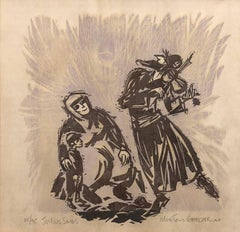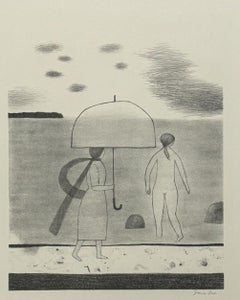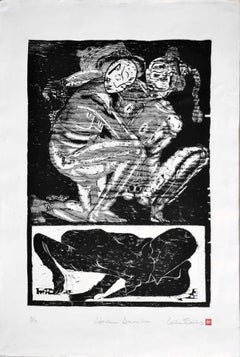Morton Garchik Prints and Multiples
to
1
Overall Width
to
Overall Height
to
1
1,160
906
792
706
1
1
1
1
Artist: Morton Garchik
Original Judaica Woodcut Print 'Joyous Songs' Dancing Jewish Couple
By Morton Garchik
Located in Surfside, FL
Original pencil signed Judaic woodcut on mulberry paper.
MORTON GARCHIK (1929-2009) Jewish American artist painter, printmaker, illustrator, woodcut artist and author. Garchik was ...
Category
20th Century Folk Art Morton Garchik Prints and Multiples
Materials
Woodcut
Related Items
Modernist FOLK ART Original Pencil Lithograph "GRAY DAY AT THE BEACH"
By Doris Lee
Located in New York, NY
Doris Lee
Lithograph
1964
Edition Size: 250
Image Size: 12 x 9.5 inches
Sheet Size: 16.75 x 13 inches
Reference: AAA 1532
Signed lower left
Condition: Good
Provenance: ASA
Doris Emr...
Category
1960s Folk Art Morton Garchik Prints and Multiples
Materials
Lithograph, Archival Pigment
$1,100
H 17 in W 13 in D 1 in
"Copula Amarilla" - Figurative Abstract Woodcut 3/10
By Cecelia Sánchez Duarte
Located in Soquel, CA
Figurative abstract wood cut print titled "Copula Amarilla" by Cecelia Sánchez Duarte. Pencil signed with edition number "3/10", title, and signature bottom margin. Image, 31.25"H x ...
Category
1990s Folk Art Morton Garchik Prints and Multiples
Materials
Archival Paper, Woodcut
$1,500
H 44.5 in W 30.25 in D 0.07 in
Blue Collograph with Horns
Located in Washington, DC
Appealing collograph Intaglio work by Noche Crist (1909- 2004). Unsigned from the 1970s but one of a kind and handprinted by the artist on thick paper. Catalogue of a postumous retr...
Category
1970s Folk Art Morton Garchik Prints and Multiples
Materials
Intaglio
Leaving Home (97-301), 5 color lithograph on Rives BFK paper, Signed/N Tamarind
By DeLoss McGraw
Located in New York, NY
DeLoss McGraw
Leaving Home (97-301), 1997
Five color lithograph on tan Rives BFK paper with deckled edges
Signed and numbered 3/75 in graphite pencil on the front
17 × 24 3/25 inches...
Category
1990s Outsider Art Morton Garchik Prints and Multiples
Materials
Lithograph
Rein Og Pulk (Reindeer and Sleighs) - Laplander Sami in his Pulk
By Yuri Mot
Located in Soquel, CA
Joyful image of a woodcut print of a Reindeer pulling a Laplander Sami in his Pulk (small toboggan), a traditional scene in Lapland folklore and history by Yuri Mot. Signed indistinc...
Category
1970s Folk Art Morton Garchik Prints and Multiples
Materials
Woodcut, Laid Paper
$950
H 24 in W 19 in D 1 in
Adam & Eve, Folk Art Woodblock by W Hahn
Located in Long Island City, NY
W Hahn - Adam & Eve, Year: 1954, Medium: Woodblock on Japon, signed, titled, numbered and dated in pencil, Edition: 5/50, Image Size: 15 x 11 inches, Size: 18.5 x 15 in. (46.99 ...
Category
1950s Folk Art Morton Garchik Prints and Multiples
Materials
Woodcut
"Queremos Chuva!" - "We Want Rain!"- Mid Century Brazilian Figurative Abstract
By Isa Aderne
Located in Soquel, CA
An allegorical, mid-century woodcut print titled, "Queremos Chuva!", or "We want rain!" (trans. from Old Portuguese) by Brazilian artist Isa Aderne (b. 1923). ...
Category
1960s Folk Art Morton Garchik Prints and Multiples
Materials
Woodcut, Paper
$1,850
H 15.25 in W 27.57 in D 0.25 in
The Jewish Holidays, Modern Portfolio of 22 lithographs by Chaim Gross
By Chaim Gross
Located in Long Island City, NY
The Jewish Holidays portfolio by Chaim Gross. This portfolio consists of 11 color lithographs plus 11 black and white lithographs of the same images depicting 11 of the Jewish Holid...
Category
1960s Folk Art Morton Garchik Prints and Multiples
Materials
Lithograph
$7,200 Sale Price
20% Off
H 19 in W 25 in
Serpientes Cafe - Figurative Abstract Woodcut
By Cecelia Sánchez Duarte
Located in Soquel, CA
Figurative abstract woodcut print titled "Serpientes Cafe" by Cecelia Sánchez Duarte. Pencil signed with "P/A" (Artist Proof), title, and signature bottom margin. Image, 31"H x 23.25"W.
Sanchez Duarte is a visual artist and a cultural activist. Cecelia also teaches Art History at Escuela Profesional de Danza de Mazatlán, is the Fine Arts Coordinator at Centro Municipal de Artes, cofounder of the new Técnico en Artes Plásticas and founder of a painting workshop for children. She has had more than 300 collective exhibits internationally as well as 17 solo shows. Cecelia Sánchez Duarte lives in Mazatlán, Mexico. Cecilia Sánchez Duarte became the new director of the Art Museum of Mazatlan in 2017. Cecilia Sanchez Duarte works in printmaking at the Taller Experimental de Estampa Jose Guadalupe Posada...
Category
1990s Folk Art Morton Garchik Prints and Multiples
Materials
Archival Paper, Woodcut
$1,500
H 44.25 in W 30 in D 0.07 in
The Couple - Figurative Abstract Woodcut
By Cecelia Sánchez Duarte
Located in Soquel, CA
Figurative abstract woodcut print titled "Copula Negra" circa 1990, by Cecelia Sánchez Duarte. Pencil signed with "P/A" (Artist Proof), title, and signature bottom margin. Image, 31....
Category
1990s Folk Art Morton Garchik Prints and Multiples
Materials
Archival Paper, Woodcut
$1,500
H 44.25 in W 30 in D 0.07 in
Descanso (Break)
By Jorge Dumas
Located in Fairlawn, OH
Signed, titled and numbered in pencil
Edition: 250 (5/250)
Signed, titled and numbered in pencil
Published by Circle Gallery Ltd.
Printer: Atelier Dumas, New York
Condition: Very good
Atelier Dumas opened in New York printing own work as well as
those of Peter Max, Agam, Romare Bearden, Dali, Erté, Peter Hurd,
Ting, Karl Appel...
Category
1970s Folk Art Morton Garchik Prints and Multiples
Materials
Lithograph
"Sitting Bull Goes To Washington"
Located in Washington, DC
Silkscreen work by Noche Crist (1909- 2004). Work is from from her "Sitting Bull Goes to Washington" series. Marked in pencil 15/18 lower left. Printed in 1976 by the artist. Catalo...
Category
1970s Outsider Art Morton Garchik Prints and Multiples
Materials
Paper
Previously Available Items
Original Judaica Woodcut Print 'Joyous Songs' Dancing Jewish Couple
By Morton Garchik
Located in Surfside, FL
Original pencil signed Judaic woodcut on mulberry paper.
MORTON GARCHIK (1929-2009) Jewish American artist painter, printmaker, illustrator, woodcut artist and author. Garchik was ...
Category
20th Century Folk Art Morton Garchik Prints and Multiples
Materials
Woodcut
Morton Garchik prints and multiples for sale on 1stDibs.
Find a wide variety of authentic Morton Garchik prints and multiples available for sale on 1stDibs. You can also browse by medium to find art by Morton Garchik in woodcut print and more. Not every interior allows for large Morton Garchik prints and multiples, so small editions measuring 19 inches across are available. Customers who are interested in this artist might also find the work of Gustavo Montoya, Dora Szampanier, and Ralph Fasanella. Morton Garchik prints and multiples prices can differ depending upon medium, time period and other attributes. On 1stDibs, the price for these items starts at $400 and tops out at $400, while the average work can sell for $400.



